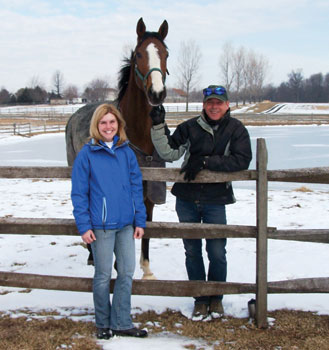 |
| Justine Howell and Hugh Cann have teamed up to take thoroughbreds from yearlings to racing to post-track careers -- all under one roof in Cochranville, PA. |
by Marcella Peyre-Ferry
Within one barn in Chester County, Thoroughbreds can get their start as youngsters before heading to the track, then return for intensive training to go from racing to a new careers as jumpers, eventers, or hunters.
The barn is in Cochranville, Chester County, where Justine Howell operates Whysper Wynd Farm under the same roof with Hugh Cann of Simply Training. The facility has 11 stalls, a sand ring, grass field, dressage ring, access to a large indoor arena and plenty of pasture, but the unusual feature of the operation is how well the two trainers mesh with the Thoroughbred as their specialty.
Justine comes to Thoroughbreds naturally. Her parents, Larry and Kathy Antus, are both former jockeys who retired from that end of the sport in the 1980's and now operate the Antus Racing Stable in the Erie, PA area. "I grew up in it," Justine said, explaining that she left the horse business for a time after marrying her husband Marc. Because Marc is an actuarial pension consultant, his job keeps him in the Philadelphia area, while they live in nearby Downingtown, Chester County. From there, Justine found Hugh, who was looking for someone to share stable space. "When I talked to him, it was a natural fit," she said.
Believe in the Breed
Hugh has an extensive background in both showing and racing. "I know the two disciplines very well. When they passed the slots bill, I looked at that and realized here in three or four more years, we're going to be awash in some very nice Thoroughbreds," he said. "I believe very strongly in the breed."
Maintaining her connection to racing through her parents, Justine is able to put her talent with young horses to work. "My parents send me babies to break and I send them up to Erie to run," she said.
Justine prefers to take in late yearlings or early two year olds, and keeps them an average of 60 to 90 days. Her clients frequently come from referrals from her parents, but she will take any young horse to break. "I do do other breeds, but I specialize in Thoroughbreds. My goal is to have them really broke," she said. "Some come from people who breed a few a year, some have bought horses out of the sales - it runs in all directions."
Hugh sees the same kind of horses a bit later in their lives, after their racing career is over. Even though they have been raced, horses are not always well broken when they leave the track. "When I get horses from the track, they have the barest knowledge about being ridden. People way overestimate the amount of knowledge that horse has," he said. "Nobody in the racing field has time to teach good manners. On average they are handled 45 minutes to an hour a day, day in and day out."
Limited Training
With their limited experience under saddle there is more to training a horse off the track than riders may realize. "I'm going to assume they get the standard 60 to 90 days (breaking) and that's all. There's a minimum of a hard year ahead of them, I'm talking about 200 days of work."
With a racing career, horses are also put to physical challenges that have to be addressed as well. "Every horse comes in here sore behind. That's one of the things I have to work through," Hugh said.
Where the horses eventually end up can vary as much as the individual, but Hugh sees the potential in many of them for jumpers and event horses "The horse tells you that," he said. "There are a lot of stereotypes out there."
Today's trend in using warmbloods for show hunters leaves the more high strung Thoroughbreds in less demand for that field. "They're not terribly well suited to show hunters. They are much more suited, by temperament and breed, to show jumping and eventing," Hugh said, adding that they also do well in the dressage phase of eventing. "You can have more of an edge on a horse in a dressage class."
Viable Candidates
Hugh can recall the time before warmbloods became popular, when getting a Thoroughbred off the track to make into a show horse was common. He does not mind dealing with the breed's spirited temperament. "They forced us to be better horsemen," he said. "The message I'm trying to get out is they are a viable candidate for today's sports. American riders did very well when we competed with Thoroughbreds."
In his present operation for the past year and a half, Hugh has had time to produce some nice mounts that are now ready to move on to new owners. "My horses have got their year, they're ready for people to come in and take a look at them," he said.
There is a wide range of buyers for Hugh's product. "They run the full range starting with first time horse owners to people that come in that are looking to move up and they're looking at Thoroughbreds." he said.
Justine is also seeing an increase in her work with the time of year. "Now that it's spring, I'm having an up-tick," she said adding that she is trying to keep her rates affordable because of the economy.
Justine is committed to the quality of the work that she does with the horses, to the point where she would like to see her name on their papers. "If you see a horse at auction and I broke it, take a chance on it. If you have trouble call me for help," she said.